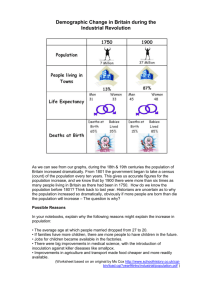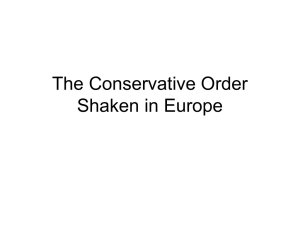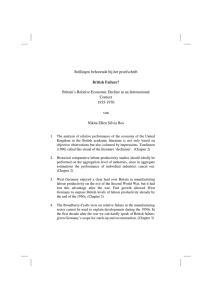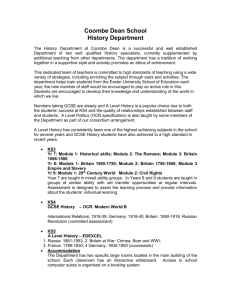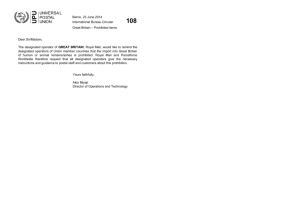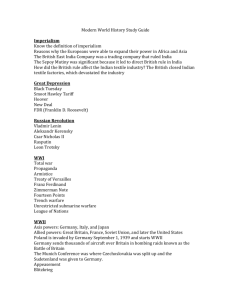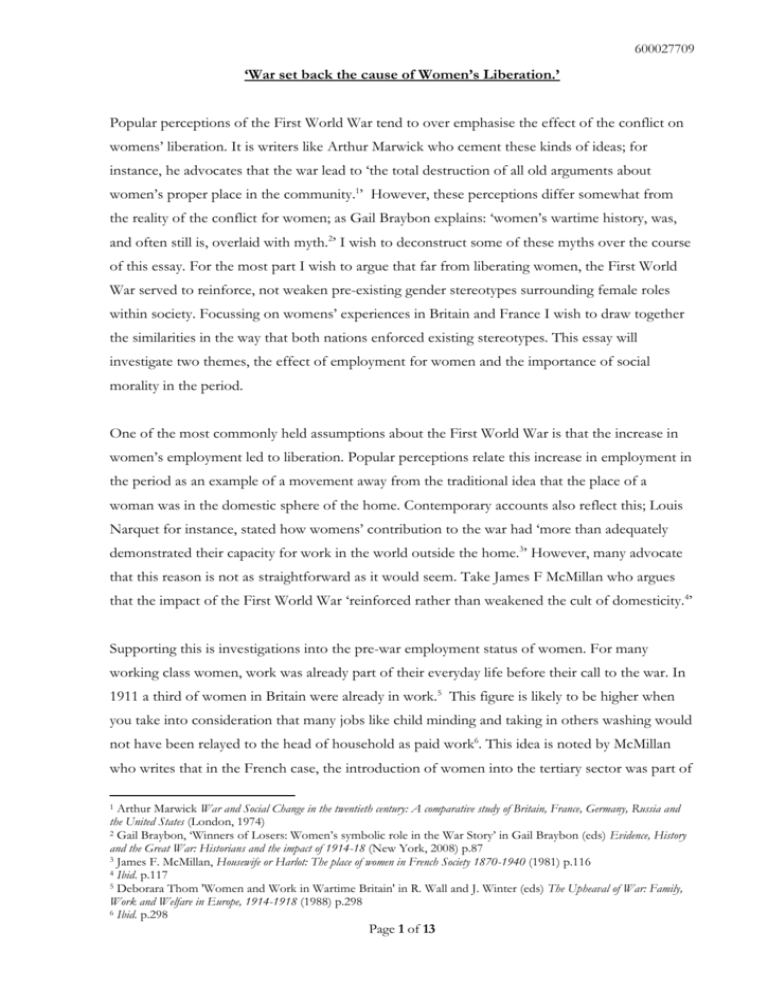
600027709
‘War set back the cause of Women’s Liberation.’
Popular perceptions of the First World War tend to over emphasise the effect of the conflict on
womens’ liberation. It is writers like Arthur Marwick who cement these kinds of ideas; for
instance, he advocates that the war lead to ‘the total destruction of all old arguments about
women’s proper place in the community.1’ However, these perceptions differ somewhat from
the reality of the conflict for women; as Gail Braybon explains: ‘women’s wartime history, was,
and often still is, overlaid with myth.2’ I wish to deconstruct some of these myths over the course
of this essay. For the most part I wish to argue that far from liberating women, the First World
War served to reinforce, not weaken pre-existing gender stereotypes surrounding female roles
within society. Focussing on womens’ experiences in Britain and France I wish to draw together
the similarities in the way that both nations enforced existing stereotypes. This essay will
investigate two themes, the effect of employment for women and the importance of social
morality in the period.
One of the most commonly held assumptions about the First World War is that the increase in
women’s employment led to liberation. Popular perceptions relate this increase in employment in
the period as an example of a movement away from the traditional idea that the place of a
woman was in the domestic sphere of the home. Contemporary accounts also reflect this; Louis
Narquet for instance, stated how womens’ contribution to the war had ‘more than adequately
demonstrated their capacity for work in the world outside the home.3’ However, many advocate
that this reason is not as straightforward as it would seem. Take James F McMillan who argues
that the impact of the First World War ‘reinforced rather than weakened the cult of domesticity.4’
Supporting this is investigations into the pre-war employment status of women. For many
working class women, work was already part of their everyday life before their call to the war. In
1911 a third of women in Britain were already in work.5 This figure is likely to be higher when
you take into consideration that many jobs like child minding and taking in others washing would
not have been relayed to the head of household as paid work6. This idea is noted by McMillan
who writes that in the French case, the introduction of women into the tertiary sector was part of
Arthur Marwick War and Social Change in the twentieth century: A comparative study of Britain, France, Germany, Russia and
the United States (London, 1974)
2 Gail Braybon, ‘Winners of Losers: Women’s symbolic role in the War Story’ in Gail Braybon (eds) Evidence, History
and the Great War: Historians and the impact of 1914-18 (New York, 2008) p.87
3 James F. McMillan, Housewife or Harlot: The place of women in French Society 1870-1940 (1981) p.116
4 Ibid. p.117
5 Deborara Thom 'Women and Work in Wartime Britain' in R. Wall and J. Winter (eds) The Upheaval of War: Family,
Work and Welfare in Europe, 1914-1918 (1988) p.298
6 Ibid. p.298
1
Page 1 of 13
600027709
a ‘more general transformation already well under way before 1914.7’ It is also worth noting that
in the immediate outbreak of war women’s employment actually dropped rather than rose. It was
not until 1915 that work for the war effort was opened up to women. 8 From this, arguments that
the war directly caused women to be employed are revealed to be flawed. While it is undeniable
that the war did contribute to a rise in employment during 1915-1918 it is wrong to understate
the amount of women in employment before then. For instance many of the jobs taken in the
factories were by those women that had previously been employed in the Textile trade.9 Deborah
Thom extends this notion, arguing that to some extent the rise in employment during the war
years was a transformation which was inevitable. She emphasises how ‘much of the ‘new’ labour
of the second half of the war in Britain came from women entering employment for the first
time because of their age and not through the removal of social inhibitions.10’
Working womens’ experience in the factories were not, contrary to some opinions, as ‘uplifting
or life enhancing11’ as some tend to think. Despite the high demand for women workers after
1915 they were still treated as inferior to their male colleagues, and were only hired ‘reluctantly12’
because of labour shortages. Many women in this sphere were merely seen as ‘substitutes13’ for
soldiers fighting at the front. This notion is reinforced in the way that after the war
demobilisation meant that women were expected to give their jobs back to the men who
fought.14’ A woman’s inferiority was also reflected in the low wages that they were paid. This is
seen in the wages of a working class woman in France; a survey by the Union des Métaux (Journal
of Metalworkers federation) found that ‘in many jobs women’s output was identical to men’s,
although the wages they received were considerably lower.15’ Many employers justified the
differences in pay when compared to men by classing all women as ‘unskilled.16’ As well as these
lower wages women were expected to work in harsh conditions, ‘even right wing nationalists (in
France) were prepared to concede that war was more likely to bring suffering rather than
liberation.17’ Concerns over conditions were predominantly focussed on munitions workers in
Britain, even though workers in other jobs were also faced with harsh working environments. For
instance, a needlewomen in Southampton reported as to having ‘no heating, no washrooms and
McMillan, Housewife or Harlot p.122
Rex Pope, War and Society in Britain, 1899-1948 (New York, 1991) p.21
9 Thom 'Women and Work in Wartime Britain' p.298
10 Ibid p.310
11 McMillan, Housewife or Harlot p.131
12 Thom 'Women and Work in Wartime Britain' p.302
13 McMillan, Housewife or Harlot p.109
14
Susan Kingsley Kent ‘The Politics of Sexual Difference: World War I and the Demise of British Feminism’
Journal of British Studies 27: 3 (1988) p.238
15 Ibid p.135
16 Susan Pedersen Family, Dependence and the Origins of the Welfare State: Britain and France 1914-1945 (Cambridge, 1995)
p.94
17 McMillan, Housewife or Harlot p.136
7
8
Page 2 of 13
600027709
no medical facilities’ whilst still working long hours.18 The way in which women workers were
reported in the press reflects these traditional gender stereotypes. Rex Pope notes how the press
reported with the ‘patronising wonder to the things women achieved’19 and mostly focussed on
their appearance. A correspondent for the Daily Mail reported the following about a female
factory worker; ‘Overalled, leather- aproned, caped and goggled- displaying nether less the
women’s genius for making herself attractive in whatsoever working guise. 20’ The reaction by
employers and the popular press to women in factories and tertiary jobs show that women
worked in an arena that patronised them as inferiors and refused to treat them equally. This
seems far from liberating.
Despite the ‘myth21’ that working women as a group in the First World War were a mixture of
classes only 9% of munitions workers were from the middle or upper classes.22 For the most part
a wider variety of roles were undertaken by the middle classes instead of factory work, however
the women who chose this route were still faced with prejudices which classed them as inferior to
men. These women were more likely to be accepted into the roles that employers and those of
the time deemed to be suitable for their sex.23 Take the idea of nursing as an acceptable career for
women. In France nursing adhered to the assumption that ‘the best opportunities for women lay
in ‘feminine’ careers where their special ‘feminine’ qualities could receive maximum scope for
development.24’ This is also the case in Britain as contemporaries asserted that nursing drew on a
woman’s ‘natural capacities for caring and nurturing25’ Jenny Gould similarly points out that at
the declaration of war ‘the idea that women might play roles other than those of nurse,
fundraiser, knitter or canteen organizer was not popular.26’ McMillan’s notes how these ideas
affected a womens progression in the work place in France. While there were schools which
provided training for women to work in the commercial sector progress for female employees
was limited to positions such as secretarial work and typists.27 It is also significant to note that
the war did not propel all women into the realms of employment. Paul Ward explains how some
British ‘women accepted such constraints and operated within a gendered version of women's
Gail Braybon and Penny Summerfield ‘Out of the cage: Women’s Experiences in Two World Wars (London, 1887) p. 80
Pope, War and Society in Britain p.22
20 Braybon and Summerfield Out of the cage: Women’s Experiences p. 47
21 Ibid p. 75
22 Ibid p. 75
23 McMillan, Housewife or Harlot p. 121
24 Ibid p. 121
25 Susan R. Grayzel Women and the First World War (2002, Essex) p.37
26 Jenny Gould, ‘Women’s Military Services in First Word War Britain’ in Sonya Michel and Margaret Collins Weitz
(eds.), Behind the Lines: Gender and the Two World Wars (Yale, 1987) p.117
27 McMillan, Housewife or Harlot p.119
18
19
Page 3 of 13
600027709
active patriotism.’28 Michel and Collins Weitz cement these notions describing how while
wartime may have impelled women out of the domestic sphere, they nonetheless tended to
remain in subordinate relationships to men. 29’
The First World War also called into question the idea of a woman’s social morality. The
importance of women in the period was founded in women’s embodiment of national morale.
Motivation for men to fight stemmed from the belief that they were fighting for the protection of
their country, and in particular, their women and children. The importance of this in both
countries during the period meant that women were subject to high social obligations concerning
their morality. It can be acknowledged, then, that in order to justify the protection of their
country, women’s behaviour during wartime had to conform to traditional pre-war conceptions,
including the enforcement of gender stereotypes. Horne describes this expectation as a ‘duty’ of
‘maintaining normality’ for the benefit of the troops at war. 30 These expectations, inevitably
caused conflict between the need for women workers as discussed above and the conceptions of
the domestic sphere in which women were seen to belong. Susan Grayzel explains this conflict of
interests as the ‘dual obligations’ expected of women31.
These differing expectations are evident when considering the conflict between a woman’s
significance as a mother and her work obligations. As death tolls rose, the importance attributed
to women as mothers increased32. These tensions were identified by contemporaries of the time.
M Lambert of France described a ‘crisis of the hearth’ where he worried that women were opting
for work rather than maternity. 33 These fears were mirrored by some British too: Alex Thomson,
also warned of that by allowing women to work this may lead to them disregarding their roles as
mothers. 34 Extending from this, one Times correspondent described women’s contribution to war
work as a ‘high price to pay’ for the impact it would inevitably have on their maternal duties35.
These concerns lead to the formation of views that attributed motherhood as a patriotic duty to
the nation.36 . The importance placed on motherhood in both Britain and France only served to
Ward, P., 'Women of Britain Say Go: Women's Patriotism in the First World War' in Twentieth Century British
History 12:1 (2001) p.28
29 Sonya Michel and Margaret Collins Weitz ‘Introduction’ in Sonya Michel and Margaret Collins Weitz (eds), Behind
the Lines: Gender and the Two World Wars (Yale, 1987) p.3
30 John Horne, ‘Social Identity in War: France 1914-1918’ in T.Frazer and K. Jeffery (eds.) Men, Women and War: Irish
Historical Studies (1993) p. 121
31 Susan R. Grayzel, Women’s Identities at War: Gender, motherhood and politics in Britain and France during the First World
War (North Carolina, 1999) p.119
32 Ibid p.87
33 McMillan, Housewife or Harlot p.117
34 Grayzel, Women’s Identities at War p.111
35 The Times, 24 Jun. 1916
36 Michel and Weitz ‘Introduction’ p.2
28
Page 4 of 13
600027709
reinforce gender stereotypes: ‘Whatever they did, they were always ‘women’ usually regarded as
potential or actual mothers.37
In Britain, this concern lead to the introduction of a number of welfare measures as ‘policy
makers sought to ensure that war work would not damage women’s capacity for their future
reproductive role.38’ These welfare measures did not, significantly, lead to higher wages. In
France, welfare policies like those in Britain were not developed and while the government tried
to organise women on the same terms of men39 this allowed for their exploitation. 40 The conflict
of war work and pre-existing gendered assumptions did not just take the form of concerns over
motherhood. The move away from the domestic sphere was also discussed amongst social
commentators. This is somewhat ironically reflected in Rebecca West’s The Cordite Makers,
originally published in The Daily Chronicle in 1916. Throughout the text, West uses domestic
imagery in describing the activities of factory girls which represents the conflict between the
home and work. At one point, for instance she writes that the girls ‘look as if they were practicing
a neat domestic craft rather than a deadly domestic process.41’
The embodiment of national morale by women is reflected in the way that they are represented in
France and Britain’s recruitment posters during the war years. The importance of women and
children as a reason to fight is particularly seen in a British recruitment poster entitled ‘Women of
Britain Say Go!’ (Appendix i) In the poster a ‘traditional England’ is depicted in the rolling green
hills of the backdrop of the poster, this traditional stereotype of the country reinforces the idea
that a woman’s place is in the home. A little boy clinging to the two women as they wave the men
off to war conforms to the idea that it is the father’s duty to go to war to protect the women and
children while it is the women’s duty to look after children in the home. This thus reinforces the
notions that a woman’s ‘primary duty42’ was to be a mother in the domestic sphere, viewed by
one Times correspondent as their ‘traditional place.43’ The separation of women and children from
the men in the poster by the window frame reinforces this idea of a gender separation. This is
examined more closely by Horne who investigates the separate identities of men and women in
First World War France. Although these identities changed in the duration, for the most part the
war was defined by the masculine aspects of the front line and the more feminised home front;
Grayzel, Women’s Identities at War p.5
Pedersen Family, Dependence and the Origins of the Welfare State p.98
39 Ibid p.103
40 Ibid p.104
41 Rebecca West, The Cordite Makers in Jane Marcus (eds.) The Young Rebecca: Writings of Rebecca West, 1911-1917
(London 1983)
42 Grayzel Women and the First World War p.108
43 Women Workers and Their Children The Times
37
38
Page 5 of 13
600027709
extending from this he notes that women were subordinated to the ‘male authority embodied in
the warrior.’44 The recruitment poster also subscribes women to the role of sending off the men
to war, this persuasive technique was continuously used throughout the war, and many regarded
this action as their ‘patriotic duty.45’ This is supported by McMillan who notes that in France
‘Mothers who gave their sons and husbands only to lose them on the field of battle were singled
out as incomparable patriots.’46
Traditional stereotypes of women were also reinforced during the war by the victimisation of
women in propaganda as a persuasion technique. The posters which used German atrocities for
recruitment ‘emphasized women’s primary status as passive victims of the war.47’ Stories of the
rape of French women by Germans reinforced the idea of women needing protection. By using
the rape of female body in French propaganda to symbolise a masculine failure to protect their
women French propagandists enforced the stereotype of ‘weak’ women that needed to be
protected by ‘strong’ men.48 The cartoon published in British magazine Punch reflects this idea
(Appendix ii.) Representation of Germans in this cartoon shows them to be evil and threatening,
images of a lifeless child and mother underneath the German soldier enforces the idea of women
as helpless to German violence. The cartoon, also like the poster above links the ruined
landscape of a nation to the death of women and children. This victimisation of women as a
persuasion technique proves to be a medium which reinforced existing gender stereotypes
because of the way in which they represent women as needing men’s protection. It is in this sense
that war ‘bolstered an understanding of gender that aimed to preserve traditional notions’ which
were reinforced by the home front/war front split.49 The public perceptions of women as
needing men’s protection enforce the idea that social morality had to be regulated because
women had to justify the ‘sacrifices’ men were making in their honour.
As already seen, the need for women’s behaviour to be in line with public expectations, both in
terms of domestic and maternal duties was seen as pinnacle to the war effort. It is often assumed
that the First World War and the new spheres it opened to women ‘lead to a sexual and morale
awakening.50’ It is clear to see where the idea of women as liberated and free in wartime came
Horne, ‘Social Identity in War: France p.122
Michel and Weitz ‘Introduction’ p.2
46 James McMillan The Great War and Gender Relations: The case of French Women and the First World War Revisited in in
Gail Braybon (eds) Evidence, History and the Great War: Historians and the impact of 1914-18 (New York, 2008) p.139
47 Grayzel, Women’s Identities at War p.52
48 McMillan The Great War and Gender Relations p.144
49 Grayzel, Women’s Identities at War p.51
50 Susan R Grayzel, ‘Liberating Women? Examining Gender, Morality and Sexuality in the First World War Britain
and France’ in Gail Braybon (eds) Evidence, History and the Great War: Historians and the impact of 1914-18 (New York,
2008) p.115
44
45
Page 6 of 13
600027709
from. Popular press and government regulations of the time reflect a concern over the behaviour
of women which was directly related to the enforcement of patriarchal roles. For instance, an
article in The Times on the 31st August 1915 entitled ‘Drinking Among Women’ expresses the
concern over the ‘wives of soldiers and sailors51’ excessively drinking. The article cites police
from the poorest areas as describing drunkenness as the ‘worse than ever they had known it.52’
The blame for this excessive drinking in the article rests on separation allowances; the article
reasons that this is how the ‘social workers in the poorest districts of London’ are funding their
escapades, resulting in their children’s suffering53. Despite what the article claims, many historians
comment on how contemporary concerns were over exaggerated.54 However, these fears were
significant enough for means of social control to be enforced on women in an attempt to ensure
that they conformed to the traditional ideals that men were fighting for. For many, women acting
in an unconventional manner was seen particularly by the middle classes as challenging excepted
gender and social expectations.55One form of this control was initiated by the denial of separation
allowances. Separation allowances in Britain and France were given to the dependents of those
soldiers fighting in the conflict. In Britain, the 1914 Army Council Memorandum of the
‘Cessation of Separation allowances and Allotments to the Unworthy’ is illustrative of control
through the denial of allowances. As a result of the act a letter was circulated to the chief
constables, which asked for their cooperation in ensuring that ‘relief shall not be continued to
persons who prove themselves unworthy to receive it.56’
It cannot however be assumed that the control of woman’s morality was purely the pursuit of
men. The Women Patrols Committee and Women Police Service, made up of women from the
middle classes, saw it as ‘their patriotic calling in policing public places for young working-class
women going astray.’57 This control particularly of working class women was not just a war time
phenomenon. There had always been an underlying distrust of the working class which
intensified during war when coupled with concerns over women working ‘long hours… with
men, journeys to and from work at night, and the existence of large number of soldiers in
barracks nears big towns.58’ Welfare workers in the factories were also used to control women.
These officers were expected to act as the ‘moral guardians of the girls’ and ‘keep them on the
The Times, 31 Aug. 1915
The Times, 31 Aug. 1915
53 The Times, 31 Aug. 1915
54 Grayzel Women and the First World War p.6
55 Angela Woollacott 'Khaki Fever' and Its Control: Gender, Class, Age and Sexual Morality on the British Home
front in the First World War’ Journal of Contemporary History 29. 2 (1994) p.337
56 Braybon and Summerfield Out of the cage p.108
57 Woollacott 'Khaki Fever' and Its Control’ p.327
58 Braybon and Summerfield Out of the cage p.107
51
52
Page 7 of 13
600027709
right track.’59 Concerns over sexual mortality were also common in the First World War, not only
due to womens’ marital duties but also because they were perceived as ‘potential carriers of
disease.60’ The British Regulation 40D decreed that ‘'no woman who is suffering from venereal
disease in a communicable form shall have sexual intercourse with any member of His Majesty 's
Forces' nor 'solicit or invite' intercourse.61 Pope talks about the double standards of morality in
terms of this. The regulation firmly places the ‘moral laxity62’ of the woman as a danger to the
nation and excuses the soldier of any blame, implying that it was the woman that could not be
trusted, assuming that men knew better. The control of women’s behaviour goes directly against
the idea that they were ‘liberated’ during the war. Far from this, women were expected to behave
as Horne states, ‘with deference, sobriety and devotion in the leave of her husband.63’ The way
that their morality was linked to their role as mother and the domestic sphere further reinforced
gender stereotypes in the period.
To conclude, gender stereotypes were heightened throughout the war period in a number of
different ways. The enforcement of these stereotypes directly opposes the ideas of those like
Marwick that the First World War aided women’s liberation. In terms of employment the
reinforcement of gender stereotypes is most clearly seen in the way that women of all classes, in
both countries were treated as inferior to male workers. Thus, the combination of harsh working
conditions and low wages does not suggest that employment particularly helped the advancement
of women. The expectation for women to conform to ‘feminine’ roles in the workplace further
reinforced existing stereotypes. The notion of duty which derived from the social expectations of
women in the period also served to enforce patriarchal ideals. The concept that women should
behave in a way that justified the reasons for men to fight meant that women had to conform to
traditional roles in aid of the war effort. The significance of motherhood, and the way that
women were viewed as purely mothers or potential mothers to the future nation in the period
also reinforced gender stereotypes. To summarise, while the advancement of employment may be
seen as liberating the treatment of women in the workplace actually only enforced traditional
stereotypes; reflected in the way that women were presented in public press and propaganda.
Social expectations were enforced by the government and members of the general public which
grounded women in the domestic sphere, a sphere in which most remained until the Second
Ibid p.90
Gould, ‘Women’s Military Services in First Word War Britain’ p.115
61 Defence of the Realm Regulations (Monthly Edition) London: HMSO, March 1918 p.68
62 Pope, War and Society in Britain p.29
63 John Horne, ‘Social Identity in War: France 1914-1918’ in T.Frazer and K. Jeffery (eds.) Men, Women and War: Irish
Historical Studies (1993) p.125
59
60
Page 8 of 13
600027709
World War. As Martin Pugh comments, if women were truly ‘liberated’ in the First World War,
why did they have to be liberated’ all over again in 193964?
64
Martin Pugh Women and the Women’s Movement in Britain 1914-1959 (Basingstoke, 1992) p.5
Page 9 of 13
600027709
Bibliography
Primary Sources
First World War Cartoon, Punch Magazine Archives, ‘The Triumph of Culutre’
www.punch.photoshelter.com (Last Acsessed: 14th November 2012)
First World War Recruitment poster, Imperial War Museum Collections, ‘Women of Britain Say
Go!’ www.iwm.org.uk/collections/item/object/14592 (Last Acsessed: 14th November 2012)
‘Drinking Among Women: Allowances spent in public houses’ The Times, 31 Aug. 1915
‘Women Workers and Their Children: Care at home and at school’ The Times, 24 Jun. 1916
Defence of the Realm Regulations (Monthly Edition) London, HMSO, March 1918 p.68
Rebecca West, ‘The Cordite Makers’ in Jane Marcus (eds.) The Young Rebecca: Writings of Rebecca
West, 1911-1917 (London 1983)
Secondary Sources
Braybon, Gail and Summerfield, Penny. ‘Out of the cage: Women’s Experiences in Two World Wars
(London, 1887)
Braybon, Gail. ‘Winners of Losers: Women’s symbolic role in the War Story’ in Gail Braybon
(eds) Evidence, History and the Great War: Historians and the impact of 1914-18 (New York, 2008)
Gould, Jenny. ‘Women’s Military Services in First Word War Britain’ in Sonya Michel and
Margaret Collins Weitz (eds.), Behind the Lines: Gender and the Two World Wars (Yale, 1987)
Grayzel , Susan R. Women’s Identities at War: Gender, motherhood and politics in Britain and France during
the First World War (North Carolina, 1999)
Grayzel, Susan R. ‘Liberating Women? Examining Gender, Morality and Sexuality in the First
World War Britain and France’ in Gail Braybon (eds) Evidence, History and the Great War: Historians
and the impact of 1914-18 (New York, 2008)
Grayzel, Susan R. Women and the First World War (2002, Essex)
Horne, John. ‘Social Identity in War: France 1914-1918’ in T.Frazer and K. Jeffery (eds.) Men,
Women and War: Irish Historical Studies (1993) p. 121
Kent, Susan Kingsley. ‘The Politics of Sexual Difference: World War I and the Demise of British
Feminism’ Journal of British Studies 27: 3 (1988)
Marwick, Arthur. War and Social Change in the twentieth century: A comparative study of Britain, France,
Germany, Russia and the United States (London, 1974)
McMillan, James F. Housewife or Harlot: The place of women in French Society 1870-1940 (1981)
Michel, Sonya and Collins Weitz, Margaret. ‘Introduction’ in Sonya Michel and Margaret Collins
Weitz (eds), Behind the Lines: Gender and the Two World Wars (Yale, 1987)
Page 10 of 13
600027709
Ward, Paul 'Women of Britain Say Go: Women's Patriotism in the First World War' in Twentieth
Century British History 12:1 (2001)
Pedersen, Susan Family, Dependence and the Origins of the Welfare State: Britain and France 1914-1945
(Cambridge, 1995)
Pope, Rex. War and Society in Britian, 1899-1948 (New York, 1991)
Pugh, Martin. Women and the Women’s Movement in Britain 1914-1959 (Basingstoke, 1992)
Thom, Deborara. 'Women and Work in Wartime Britain' in R. Wall and J. Winter (eds) The
Upheaval of War: Family, Work and Welfare in Europe, 1914-1918 (1988)
Woollacott, Angela. 'Khaki Fever' and Its Control: Gender, Class, Age and Sexual Morality on
the British Home front in the First World War’ Journal of Contemporary History 29. 2 (1994)
Page 11 of 13
600027709
Appendices
Appendix i: First World War Recruitment poster, Imperial War Museum Collections
Page 12 of 13
600027709
Appendix ii: First World War Cartoon, Punch Magazine
Page 13 of 13


